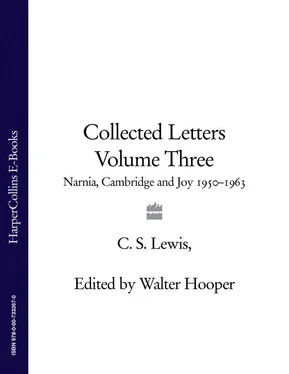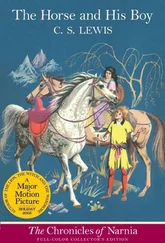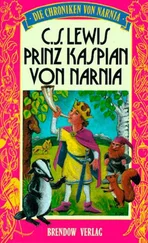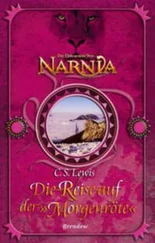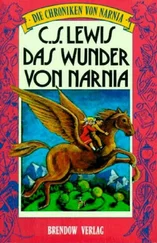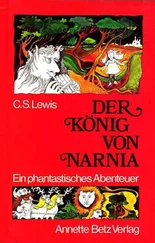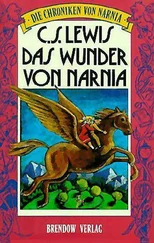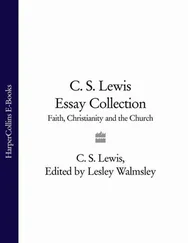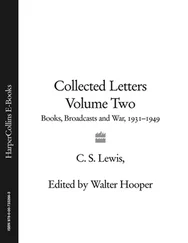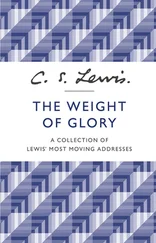231Mrs Farrer took exception to Lewis’s portrayal of God as, not male, but masculine . In That Hideous Strength , ch. 14, part V, p. 350, Ransom tells Jane Studdock: ‘You are offended by the masculine itself: the loud, irruptive, possessive thing–the gold lion, the bearded bull–which breaks through hedges and scatters the carefully made bed. The male you could have escaped, for it exists only on the biological level. But the masculine none of us can escape. What is above and beyond all things is so masculine that we are all feminine in relation to it.’ that he was born blind? Jesus answered, Neither hath this man sinned, nor his parents: but that the works of God should be made manifest in him.’
232Lewis was referring to the love of the dwarf, Gimli, for Galadriel, Queen of the Elves, in The Lord of the Rings: The Fellowship of the Ring , Bk. II, ch. 7: ‘The Dwarf, hearing the names given in his own ancient tongue, looked up and met her eyes, and it seemed to him that he looked suddenly into the heart of an enemy and saw there love and understanding.’
233In The Fellowship of the Ring , Bk. II, ch. 8, ‘Farewell to Lórien’, the Fellowship takes leave of the security of Lothlórien to destroy the Ring.
234In the final chapter of The Fellowship of the Ring , the noble Boromir covets the Ring so badly he tries to take it from Frodo: ‘“It is by our own folly that our Enemy will defeat us,” cried Boromir. “How it angers me! Fool! Obstinate fool! Running wilfully to death and ruining our cause. If any mortals have claim to the Ring, it is the men of Númenor, and not Halflings. It is not yours save by unhappy chance. It might have been mine. It should be mine. Give it to me!”’
235See the letter to Sir Stanley Unwin of 4 December 1953.
236‘make haste slowly’.
237The Roman poet Lucretius (c. 99-c. 55 BC).
238Lewis was referring to D. E. Harding’s The Hierarchy of Heaven and Earth .
239ibid., Preface, p. 12: ‘It would be affectation to pretend that I know whether Mr. Harding’s attempt, in its present form, will work. Very possibly not. One hardly expects the first, or the twenty-first, rocket to the Moon to make a good landing. But it is a beginning.’
240See Dorothy L. Sayersin the Biographical Appendix to CL II, pp. 1065-72.
241Lewis had received one of Sayers’ Christmas cards. The text, ‘The Days of Christ’s Coming’, was by Sayers, with a painting by Fritz Wegner, and the card was printed by Hamish Hamilton. The picture had 27 numbered doors to be opened from 14 December to 7 January
242Kathleen Nott had just published The Emperor’s Clothes (London: Heinemann, 1953), described on the jacket as ‘An attack on the dogmatic orthodoxy of T. S. Eliot, Graham Greene, Dorothy Sayers, C. S. Lewis, and others.’
243A Scots word for money or silver.
244Sayers’ first part of Dante’s Divine Comedy had been published in 1949. She was now working on her translation of the Purgatorio .
245David Gresham was in fact nine and a half years old and Douglas eight.
246The ‘Little Kingdom’ of J. R. R. Tolkien’s Farmer Giles of Ham (1949) is set in that pleasant area east of Oxford which includes Thame, Long Crendon and Worminghall.
247Arthur C. Clarke, Childhood’s End (New York: Ballantine, 1953).
248H. G. Wells, The First Men in the Moon (1901).
249Olaf Stapledon (1886-1950), whose Last and First Men (1930) and Star Maker (1937) are mentioned in CL II, pp. 236, 594.
250i.e., Richard Wagner’s Ring of the Nibelung , one of Lewis’s oldest loves. See the references to it in CL I, pp. 29, 139n, 381-2.
251Clarke, Childhood’s End , ch. 21, p. 163.
252ibid., p. 164.
253Luke 14:26.
254But in Book V when they have returned to Sicily, the women try to burn the ships so they need not go to Latium. See CL 11, p. 750, N. 148. In Virgil, Aeneid , Book III Aeneas and his companions build a fleet and set off in search of the land that first bore the Trojan race (Italy). They have many strange adventures along the way, but eventually reach Libya.
255That is, from matters of the soul (psyche) to those of the spirit (pneuma) .
256Dante, Inferno , IV, 42.
257The letter was unsigned.
258Her husband, Henry Gerard Walter Sandeman, died on 19 January 1953.
259Matthew 19:5-6; Mark 10:8-9.
260Titirangi School for the Deaf had now merged with the Kelston Deaf Education Centre, New Lynn, Auckland, and Bodle had moved to New Lynn to continue her teaching.
261Herbert, The Temple , ‘The Church-porch’, Stanza 72, 5-6: ‘If all want sense, God takes a text, and preacheth Patience.’
262The Rev. Canon Ronald Edwin Head (1919-91) was appointed Curate of Holy Trinity, Headington Quarry, in 1952, and Vicar in 1956. When he arrived in the parish Holy Communion was celebrated at 8 a.m. and Morning Prayer at 11 a.m. He was responsible for reversing the times of these services.
263Lewis may have been remembering Joanna Baillie (1762-1851), ‘The Storm-Beat Maid’ (1790), XL, 1: ‘I’ll share the cold blast on the heath.’
264The four women are characters in the works of William Shakespeare. Imogen is the heroine of Cymbeltne (1623), Portia the heroine of The Merchant of Venice (1600). Miranda is a character in The Tempest , and Perdita appears in The Winter’s Tale (1623). While Miranda and Perdita grew up in sheltered circumstances and made happy marriages, Imogen and Portia had complicated and eventful lives which nevertheless turned out well in the end.
Конец ознакомительного фрагмента.
Текст предоставлен ООО «ЛитРес».
Прочитайте эту книгу целиком, купив полную легальную версию на ЛитРес.
Безопасно оплатить книгу можно банковской картой Visa, MasterCard, Maestro, со счета мобильного телефона, с платежного терминала, в салоне МТС или Связной, через PayPal, WebMoney, Яндекс.Деньги, QIWI Кошелек, бонусными картами или другим удобным Вам способом.
